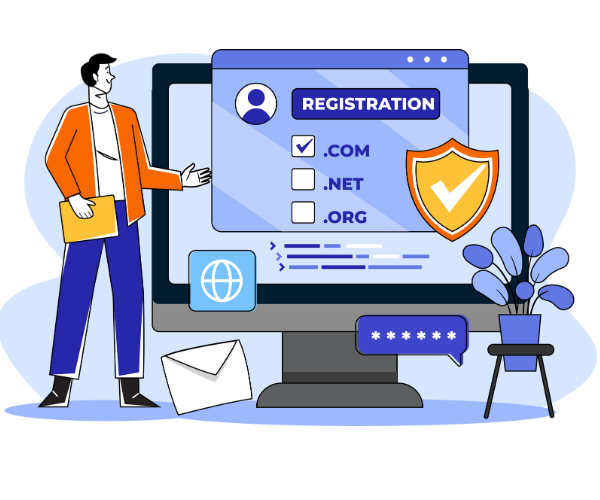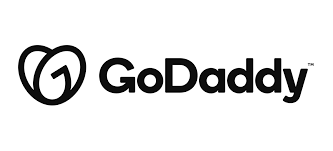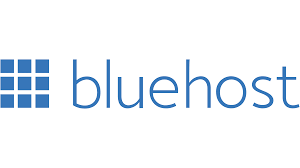Disclaimer: If you purchase via links on our site, we may receive affiliate commissions
Updated in April 2025
Top 10 Best Domain Registration Platforms in 2025
Whether you are starting a website, protecting your brand, or investigating domain investments, it is important to choose the right domain registration platform. This guide provides some answers to common questions about how domain registration platforms work, their pricing, privacy features, ways to steer clear of scams, and features of trusted platforms like Namecheap, GoDaddy and Hostinger. For first-time users and businesses alike, we'll show you everything about domain registration and guide you towards the right path.

10 Best Domain Registration Platforms in 2025

- Domain Registration
- Domain Transfer
- Website Hosting

- Domain Registration
- Domain Auctions
- WHOIS Privacy Protection

- Domain Registration
- SSL Certificates
- WHOIS Privacy Protection

- Domain Registration
- WHOIS Privacy Protection
- SSL Cerifictaes

- Website Hosting
- Domain Transfer
- Domain Registration

- WHOIS Privacy Protection
- SSL Certificates
- Website Hosting

- Website Hosting
- Domain Registration
- SSL Certificates

- WHOIS Privacy Protection
- Domain Transfer
- SSL Certificates

- Domain Registration
- WHOIS Privacy Protection
- SSL Crtificates

- Domain Marketplace
- Domain Auctions
- Domain Due Diligence Services
What Is A Domain Registration Platform? And How Do They Work?
A domain registration platform is an online service which allows a user to search for, register, and manage domain names (i.e. yoursite.com) through an accredited registrar licensed by ICANN (Internet Corporation for Assigned Names and Numbers). The domain registration platform is an intermediary between you and the domain registry. The domain registration platform is responsible for managing your record of ownership, DNS settings, etc.
How it works:
- Search: Enter your desired domain name into the platform’s domain search bar (such as the search bar in Namecheap).
- Register: Choose an available domain name and input your contact information to register and pay the registration fee.
- WHOIS Submission: The platform submits your information to the WHOIS database or through their optional WHOIS privacy protection feature.
- DNS set up: Configure your DNS to point it to your website, email or other services.
- Management: Manage new domains, renew, transfer, and configure in the dashboard provided by the platform (for example, Hostinger has hPanel).
- Example: They are the same. GoDaddy has a search bar and finds the domain name, registers your domain, and has a dashboard to point it to your website or email, etc.
Let’s get deep dive into the top 5 Domain Registration Platforms in 2025
Features:
- Namecheap offers reasonable domain registration with free WHOIS security assurance, DNS administration, and domain forwarding. They give a user-friendly space look interface and bulk domain enrollment choices.
Advantages:
- Namecheap stands out for its straightforward estimating, fabulous client back, and direct domain management tools. They too offer domain marketplace for buying and selling domains.
Use Cases:
- Appropriate for people, new companies, and businesses looking for cost-effective domain registration with security protection and reliable support.
Pricing:
- Domain registration costs change depending on the space expansion, but regularly begin from around $10.5 per year for well-known expansions.
Features:
- GoDaddy offers a wide run of domain extensions, domain privacy protection, and domain management tools. They give a user-friendly space look interface and bulk domain registration choices.
Advantages:
- Known for its broad domain stock, GoDaddy offers competitive pricing, reliable client support, and extra services like site hosting and e-mail hosting.
Use Cases:
- Perfect for people, businesses, and organizations trying to find a one-stop arrangement for domain registration, web hosting, and online presence administration.
Pricing:
- Domain registration costs change depending on the domain extension, but ordinarily begin from around $0.99 for the primary year with special offers.
Features:
- Bluehost offers domain registration nearby its facilitating administrations. They give a free space for the primary year with facilitating plans, space administration instruments, and domain protection assurance.
Advantages:
- Bluehost gives a helpful all-in-one arrangement for space enlistment and facilitating, with solid client bolster and competitive estimating. They offer consistent integration with their facilitating stage.
Use Cases:
- Appropriate for people and businesses trying to find a dependable facilitating supplier with included domain registration and management devices.
Pricing:
- Domain registration costs shift depending on the domain expansion, but ordinarily begin from around $11.99 per year for popular expansions.
Features:
- MochaHost offers a number of domain registration offerings, which includes unlimited loose domain registration with certain web hosting plans, unfastened lifetime domain for particular plans, WHOIS privateness protection, domain forwarding, and complete DNS control. It also enables smooth domain switch.
Advantages:
- MochaHost's lifetime unfastened area with pick out website hosting plans facilitates reduce long-time period costs. It provides strong control tools and WHOIS safety for greater privacy and safety. The platform is comparatively cheap for area renewals and offers reliable 24/7 customer service.
Use Cases:
- MochaHost is good for small companies and startups searching for lower priced net website hosting and domain registration bundles. It is likewise appropriate for private blogs and websites due to its price-powerful pricing and for users looking for long-time period area registration savings.
Pricing:
- Domain registration starts at around $3.18/month to $11.95/month with different features at each stage.
Features:
- Dream Host offers domain registration with a various of domain extensions, domain privacy protection, and domain administration tools. They give a user-friendly domain look interface and simple domain transfers.
Advantages:
- Dream Host gives dependable domain registration services with straightforward estimating, amazing client support, and extra services like site hosting and e-mail hosting.
Use Cases:
- Perfect for people, bloggers, and businesses looking for solid domain registration with coordinates web facilitating arrangements and management tools.
Pricing:
- Domain registration costs shift depending on the domain expansion, but regularly begin from around $8.99 per year for popular expansions.
Which domain registration platforms are accredited and secure to use?
All of the following domain registration companies from the above list are ICANN-accredited, secure, and reputable, and exceed industry standards for protecting your information (data security) by providing the following components:
Namecheap:
Namecheap offers free WHOIS privacy, an easy-to-navigate dashboard, and good data security (e.g. DNSSEC, 2FA with authenticator apps). Manage over 18 million domains.
GoDaddy:
The largest registrar with 84 million domains registered. They have a free WHOIS privacy, domain locking, and 24/7 phone support.
Hostinger:
They are ICANN-accredited, they provide WHOIS privacy for free on .com and .xyz domains, and their pricing includes free privacy features depending on the bundled hosting.
Bluehost:
Recognised primarily for hosting services, but is also ICANN-accredited for domains; offers a free domain on first-year hosting plans, and has a knowledgeable support section.
An ICANN-accredited, provides free WHOIS privacy, with an easy-to-use panel and reliable support for small businesses.
SiteGround:
An ICANN-accredited domain registration is available with hosting plans; it offers free WHOIS privacy for eligible TLDs and offers many safety features.
HostGator:
An ICANN-accredited, provides domain registration with hosting offered, and 24/7 support for your questions.
A2 Hosting:
An ICANN-accredited domain registration is included with hosting plans; it offers free WHOIS privacy on eligible TLDs and provides fast support for questions.
The Google Domains registrar is no longer active; its services were migrated to Squarespace in 2023. Flippa, Panabee, Semrush & SnapNames are not registrars; Flippa and SnapNames are marketplaces to buy/sell domains, Panabee is a domain name generator, and Semrush is an SEO tool. Infomaniak, Mochahost, and Scalahosting are not listed explicitly as ICANN-accredited in the current data; though they do offer domain services through hosting, before using, please confirm their accreditation status on ICANN’s website.
How Do I Choose Domain Registration Platforms Like Namecheap, GoDaddy, or Google Domains?
When looking to choose one of these platforms, consider your own needs (privacy, budget, technical proficiency), whether you are registering domains for yourself or your small business, etc.
Consider the following:
Namecheap
Best for – This platform is a nice option for budget users, small businesses, and those who prioritise privacy.
- Pros – Free WHOIS for life, .com domain names are affordable at $6.49 and renew at $16.98 for .com domains, an easy-to-use interface (dashboard), chat support 24/7, and there is no limit to the number of domains you can register.
- Cons: No phone support, limited features (advanced plans) for enterprise registration.
GoDaddy
Best for – Individuals or businesses that would benefit from an “all-in-one” approach, like domains, web hosting (GSA), building sites (GSA), etc.
- Pros – Free WHOIS, 500+ domain extensions, 24/7 phone/chat support, domain auctions, AI tools (GoDaddy Airo), etc.
- Cons: Renewals/domain name costs are higher (i.e., $18.17 for .com when renewal), and add-on domains can add expenses.
Google Domains – The service was discontinued in September 2023, and the domains were transferred to Squarespace. Domain options are not available in 2025.
Alternatives (from the list):
- Hostinger: Great option for beginners due to hosting bundles, free WHOIS privacy, and low-cost .com domains ($8.99/year, 69% discount for 2 years).
- Bluehost: Good option for WordPress websites, includes a free domain when you host, but WHOIS privacy is a paid add-on.
- DreamHost: Trustworthy for small businesses, free Whois privacy, intuitive panel to use.
Factors to Consider:
- Prices: Compare the first-year prices because renewal costs may differ (e.g., Namecheap is cheaper than GoDaddy for renewals).
- Privacy: Free WHOIS privacy should be a priority for companies (e.g., Namecheap, Hostinger).
- Support: Note that GoDaddy has phone support while Namecheap has chat support.
- Features: Check for DNS management, domain locking, whether they have closed auctions (e.g., GoDaddy, Flippa).
- Ease of Use: Beginners tend to prefer Hostinger’s hPanel or the dashboard layout of Namecheap.
Overall Recommendation: Namecheap for best pricing and free privacy, GoDaddy for overall services, Hostinger for hosting bundles.
What Will the Domain Registration and Renewal Costs be on the Registrar's Platform You Choose?
Pricing is all over the place, and these costs are determined by the platform, the TLD (top-level domain) such as .com or .org, and promotional agreements. Here are the available pricing for 2025 for the listed platforms below (by the data ready for publication):
Namecheap:
- Registration: .com for $6.49/year the first year, .org for $10.10, .io for $35.
- Renewal: .com for $16.98/year, .org for $11.66, .io for $35. Discounts for multi-year renewals.
Note that the ICANN fee ($0.18/year) applies to some TLDs.
GoDaddy:
- Registration: .com for $12.17/year first year, .org for $10.17, .io for $49.99.
- Renewal: .com for $18.17/year, .org for $21.17, .io for $49.99. First-year discounts on most.
Hostinger:
- Registration: .com for $8.99/year with a 69% discount for 2 years, .org for $9.99, .io for $29.99.
- Renewal: .com for anywhere from $13 – $20/year, depending on TLD. Includes a free domain with any hosting package.
Bluehost:
- Registration: .com for $12.99/year (or free first year if you purchase hosting), .org for $11.59.
- Renewal: .com for $21.99/year, .org for $18.99.
DreamHost:
- Registration: .com for $9.99/year first year, .org for $10.99. Free if you purchase hosting.
- Renewal: .com for $15.99/year, .org for $16.99.
Note: Websites like Flippa and SnapNames are marketplaces for buying and selling domains, not necessarily registrars. The auction prices vary greatly (as illustrated by the case of the domain castleonline.com going for $5,088 at auction). Pricing for Infomaniak, Mochahost, and Scalahosting is not documented. Where known, these prices tend to align with Hostinger on hosting bundles. Panabee and Semrush do not oversee domains.
Do Domain Registration Websites Provide Free WHOIS Privacy or Real Domain Privacy Protection?
WHOIS privacy (or domain privacy protection) conceals your personal information (name, address, email) from the public WHOIS database, which further reduces spam and even the risk of identity theft. Based on the platforms we discussed:
- Namecheap: Lifetime free WHOIS privacy through their Withheld for Privacy service (Iceland-based), included with all TLDs.
- GoDaddy: Free WHOIS privacy, as they swap your details with proxy details. Other site plans, such as Full or Ultimate Domain Protection, provide additional features to help protect against domain hijacking.
- Hostinger: Free WHOIS privacy on eligible TLDs (universally applied on .com, .org, does not apply on .us, .uk due to TLD rules).
- DreamHost: Free WHOIS privacy prepaid on any eligible TLD (generally includes domain registration).
- SiteGround: Free WHOIS privacy on eligible TLDs, and it observes GDPR to protect users who reside in Europe.
- HostGator: Free WHOIS privacy on eligible TLDs, included with registration.
- A2 Hosting: Free WHOIS privacy protection on eligible TLDs, but simply added for increased user privacy.
- Bluehost: WHOIS privacy is not included with their basic plans, and WHOIS privacy costs ~$15 per year as an add-on to he basic plan.
- Sites like Infomaniak, Mochahost, Scalahosting: little to no information, except they usually have WHOIS privacy as a part of their hosting plans, but be sure of their WHOIS privacy before purchasing your domain.
Remember, EU citizens typically receive automatic WHOIS redaction for their data through GDPR, and some TLDs (for example, .us or .uk) have privacy restrictions from the registry.
What are the Hidden Fees to Avoid on Registrars for Domain Names?
Hidden fees can add to your costs if you aren’t aware of them:
- ICANN Fee: For many TLDs (.com, for example) expect to pay the ICANN Fee of $0.18/year (Namecheap).
- Renewal Price Jumps: Most registrars offer amazing discounted prices for the first year and then raise the price at renewal (GoDaddy, which offers .com at $12.17 for the first year, its renewal is $18.17).
- WHOIS Privacy: Most registrars offer an additional service, which is WHOIS privacy. It’s generally free at Namecheap, free through Hostinger, but around $15 a year for Bluehost.
- Redemption Fees: If you miss the renewal date, you may be charged a redemption fee to purchase the expired domain (GoDaddy & Hostinger both charge redemption fees that are $80-$150 plus a renewal fee).
- Add-Ons: Premium domain hosting (Namecheap’s PremiumDNS is $4.88/year), SSL certificates, email hosting, or DDoS protection may come at a cost.
- Transfer Fees: You’ll find that incoming transfers may incur a fee (e.g. GoDaddy $10.99, or Hostinger $8.99), yet outgoing transfers are generally free.
- Premium TLDs: Some niche extensions (.io, .ai) come at a higher price point (GoDaddy.io at $49.99/year).
If I were to offer up a tip, know what you are paying at renewal, and always check the box to enable auto-renewal. I’ve had to toggle the auto-renew on a few times on Hostinger’s hPanel to take advantage of the hidden renewal pricing.
How Long Generally to have Domain Registration stay Active on most platforms?
Domain registration is almost always instant, but may take up to 48 hours to propagate:
- Registration: Namecheap, GoDaddy, Hostinger, Bluehost, DreamHost, HostGator, A2 Hosting, and SiteGround will register your domain name as soon as you have confirmed payment. (Instantly)
- DNS Propagation: You can expect to have your domain resolve worldwide within 24 – 48 hours, though some providers, such as Namecheap, will use Cloudflare DNS for much faster propagation.
- Activation: You are able to begin using the domain (for things such as websites, email) almost immediately, at least from the perspective of using the platform’s dashboard and tools (for example, GoDaddy’s real-time DNS tools).
As an example, if you were to register a .com with Hostinger and point the DNS to your hosting plan, you could have a website launchable in under an hour, though it would take up to a day for it to propagate.
Can I Transfer My Domain from a Registrar to a New Registrar, and What’s the Process?
Yes, it’s possible to transfer domains between registrars for cost, support, or features reasons. Here is the process:
- Check eligibility: Ensure the domain is greater than 60 days old and not recently transferred (according to ICANN).
- Unlock domain: Go to the registration dashboard of your registrar and unlock the domain (using this control panel in NameCheap); If the domain is locked, you won’t be able to transfer it.
- Get transfer code: Get your EPP/auth code from your registrar. Keep this handy.
- Initiate transfer: Go to your new registrar’s interface and click “Transfer Domain” (as in Hostinger), enter the EPP code and pay the transfer fee (a good example, GoDaddy is $10.99, Hostinger is $8.99).
- Confirm transfer: You may need to approve the transfer from an email or your dashboard (this usually takes between 30 minutes and 6 days).
- Update DNS: Now, go into your new registrar’s interface and configure your DNS.
Example: transferring from GoDaddy to Namecheap for a lower renewal fee. When I transferred, the cost included a free year of registration.
NOTE: Flippa and SnapNames are for buying and selling domains, not for transferring domains from one registrar to another.
What Happens If I Forget to Renew My Domain—Grace Period, Redemption, Auctions?
If you forget to renew your domain:
Grace Period (0-30 days after expiration):
- The domain is inactive but can be renewed at the regular price.
- You will see 0-30 day grace periods with: Namecheap, GoDaddy, Hostinger, Bluehost, DreamHost, HostGator, A2 Hosting, SiteGround.
Redemption Period (30 days from grace period):
- The domain is locked. Recovery will require payment of a redemption fee that can range from $80-$150 plus renewal.
- Available on GoDaddy, Hostinger, and Namecheap.
Pending Delete (5 days after redemption):
- The domain is in the deletion queue and cannot be recovered.
- External people and companies may register after pending deletion.
Auctions: Commonly, expired domains may be auctioned off (i.e., GoDaddy Auctions, SnapNames, Flippa, etc) if you forget to register. Generally, you have up to 30 days after the expiration to recover your domain, before the new owner’s (in the case of an auction win) rights take effect.
Tip: Use auto-renew (ie, GoDaddy offers an auto-renew option) to ensure the registration does not expire.
Can I register domains or subdomains on the same platform?
Yes, all registrars listed above support multiple domains and subdomains.
Multiple Domains:
- You can register an unlimited number of domains through Namecheap, GoDaddy, Hostinger, Bluehost, DreamHost, HostGator, A2 Hosting or SiteGround.
- Some of the options provide bulk pricing, such as GoDaddy’s Discount Domain Club and Namecheap’s bulk pricing.
Subdomains:
- Create unlimited subdomains, like blog.yoursite.com, for free on all platforms.
- GoDaddy supports up to 100 subdomains, whereas Hostinger permits unlimited subdomains for sections like blogs or stores.
Management: You can use the platform’s dashboard to manage multiple domains/subdomains (for example, a calm, uncluttered panel like Namecheap).
Example: You register “yoursite.com” and “yoursite.net” with Hostinger, and you can then create subdomains like shop.yoursite.com.
Should You Purchase Your Domain and Web Hosting from the Same Place?
Purchasing domains and hosting all in one spot has advantages and disadvantages.
Advantages:
- Convenience: Have all your account access and management from one dashboard (Hostinger’s hPanel, Bluehost’s WordPress integration, etc.).
- Free Domain: Hostinger, Bluehost, HostGator, A2 Hosting, SiteGround and DreamHost all offer free domains with hosting plans for the first year.
- Bundled Services: These may include email, SSL, or maybe even WHOIS privacy….GoDaddy has bundles for hosting.
Disadvantages:
- Lock-In: It may be difficult and/or expensive to transfer the domain later.
- Pricing: The renewal pricing can be more (Example: Bluehost.com renews at $21.99 vs Namecheap $16.98).
- Limited Selection: If you’re going through a hosting-focused platform (example: HostGator), they may have limited TLD options compared to GoDaddy.
Recommendation: It would be easier to buy from the same place if you are just starting (example: Hostinger or Bluehost) or if you have more of a likelihood of needing to upgrade/change hosting later, then you would want to separate. (example: with Namecheap for domains and SiteGround for hosting) It presents more options as well as cost savings.
How Can I Stay Safe from Domain Scams (Slaming and hijacking) at Registration Platforms?
Domain scams like slamming (leading you to switch registrars without your knowledge of it) and hijacking (stealing your domain) can be avoided by:
- Use Accredited Registrars: Use ICANN-accredited registrars for your domains, like Namecheap, GoDaddy, Hostinger, Bluehost, DreamHost, HostGator, A2 Hosting, SiteGround, etc.
- Create a Domain Lock: This prevents unauthorised transfers (also available on GoDaddy, Namecheap, Hostinger).
- Use WHOIS Privacy: Protect your information from scammers by selecting this option with registrars such as Namecheap, Hostinger, GoDaddy, and others, who will give you this option for free.
- Double-Check Your Emails: If you get unsolicited renewal or transfer requests, ignore them and only use your registrar’s dashboard if you are going to respond.
- Enable 2FA: Secure your account using 2FA and authenticator apps (Namecheap has a 2FA, for instance).
- Monitor Your Domains: Have an SMS Alert (GoDaddy has a Domain Alerts service) or monitor the WHOIS logs to verify unauthorised changes have not taken place.
- Avoid shady marketplaces: If you buy or sell domains, ensure you do it on a reliable platform (like Flippa and SnapNames) and not an unverified source.
- Enable Auto-Renewal: Enable auto-renewal so you are not subject to hijacking associated with a domain that is going to expire.
Example: Namecheap offers free WHOIS privacy and DNSSEC–it would prevent slamming and hijacking from taking place.
Conclusion
This review of Domain Registration Platforms examines the best secure and affordable domain options for domain management in 2025. Namecheap has great affordability and WHOIS privacy included for free, GoDaddy has the best comprehensive services and auctions, and Hostinger offers great value with hosting bundles.
Bluehost, DreamHost, HostGator, A2 Hosting, and SiteGround have reliable integration solutions, while Flippa and SnapNames feature investment opportunities for domain investors. To protect yourself from scams, choose accredited platforms and secure your account from potential breaches with security features like domain lock and two-factor authentication.
Explore alternative product solutions at Alternate Product and establish your online presence with confidence!



